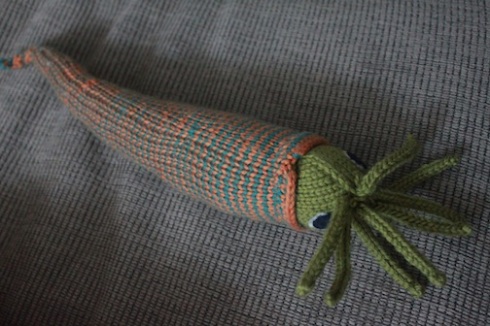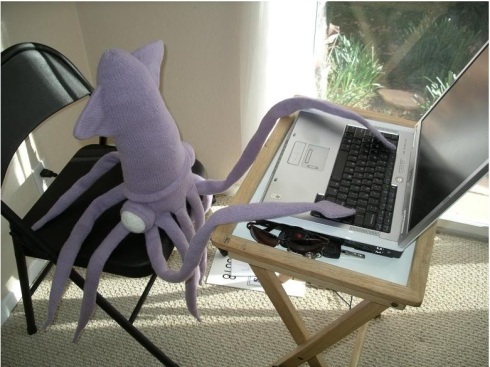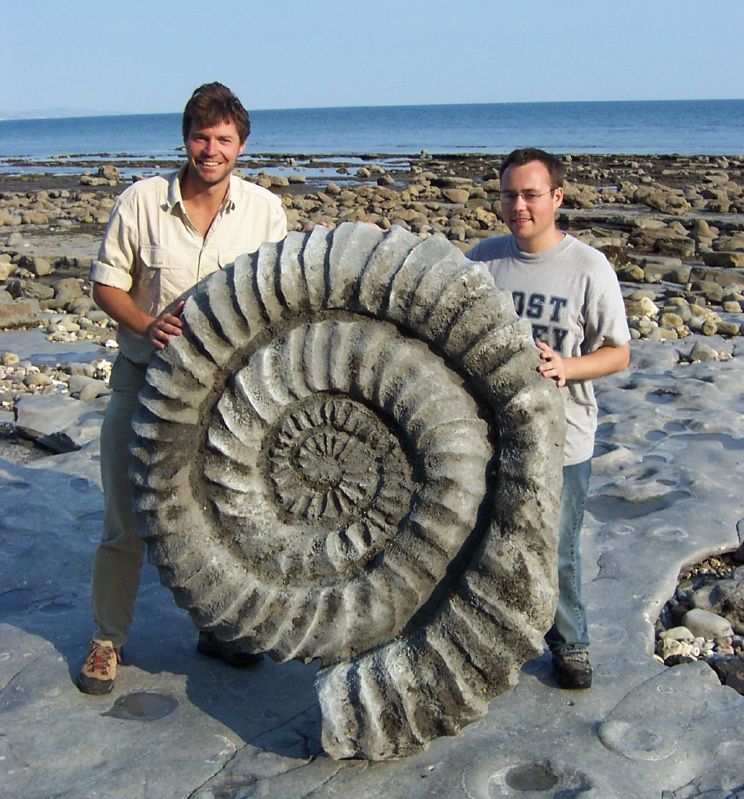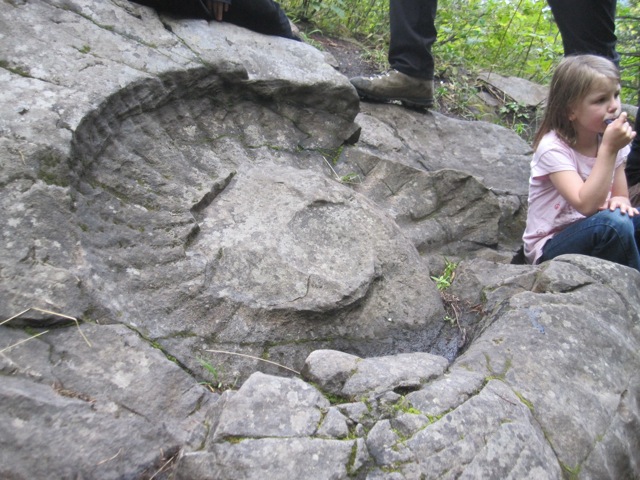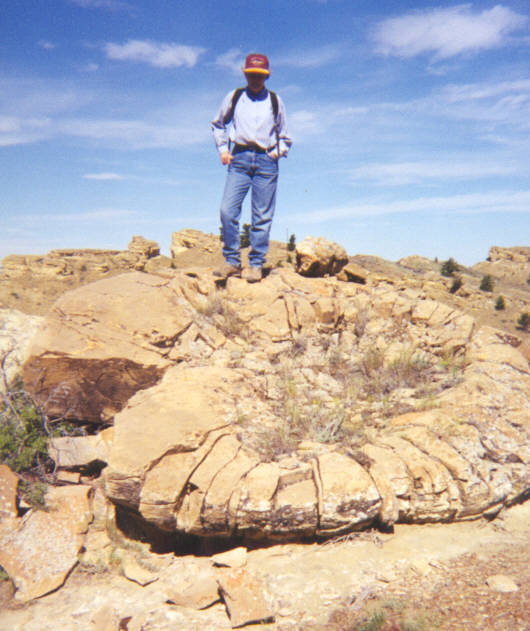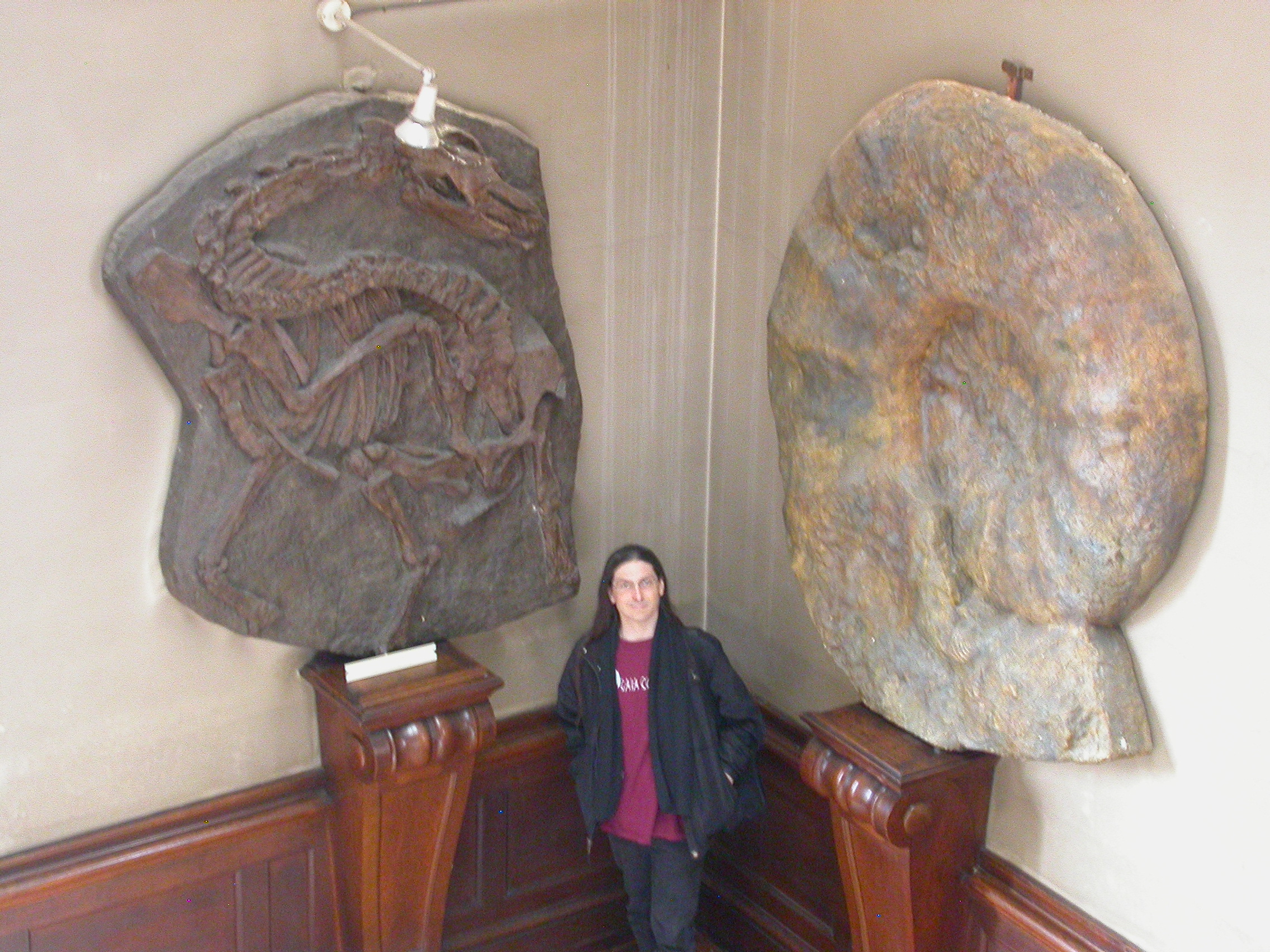You are currently browsing the tag archive for the ‘ammonite’ tag.

I have always been fascinated by cephalopods. One of my favorite parts of natural history museums is seeing the reconstructions of ancient oceans where the big gray spirals are re-imagined with the colors and textures (and tentacles) of real life. Those stunning reconstructions and thrilling artworks are based on the appearance and anatomy of modern cephalopods…and pretty much nothing else. The soft tissue of orthocones, ammonites, and belemnites is not preserved in the fossil record. Invertebrate paleontologists (and artists) have been forced to flesh in those fabulous shells with information gleaned from octopuses squids, and nautiluses.

Until now! Scientists looking at limestone “pages” from the the extraordinary Solnhofen-Eichstätt deposits southern Germany were perplexed by a weird ancient blob (above). I hope you will take a moment to look at these seemingly meaningless pink and yellow smudges and smears. Such an examination provides testament to the gifts of paleontologist Christian Klug of the University of Zurich who was able to decipher what this truly is: the body of a 150 million year old ammonite somehow removed from its shell and preserved in an anoxic lagoon.

Through Klug’s reconstructive prowess we are able to gift the anatomy of this ancient creature. Ammonoids were common in Earth’s oceans from the Ordovician until the end of the Cretaceous (a 400 million year run) and they are invaluable to geologists as index fossils, but, in some ways we don’t know much about them. Although this fossil helps us to understand their anatomy, it also engenders new questions. For example, how did this particular mollusk die? It is possible it was ripped from its shell by some Jurassic monster which then lost hold of the morsel. After watching the decaying creatures drifting in the tides of the Chesapeake, however, I am more inclined to think that the interstitial tissues which held the ammonite in its shell decayed and the dead animal slid out. This hypothesis is somewhat supported by what is still missing from this extraordinary find: the arms! Ammonite scientists would dearly love to know about the arms of these creatures. Were they numerous and weak like the arms of nautiluses? Were they long and strong like the grabbing arms of cuttlefish? Did ammonites have different sorts of arms for different purposes? (based on modern cephalopods, this would be my guess). We still don’t know, but the very existence of this fossil shows that with luck, infinite patience, and Professor Klug’s sharp eyes, it is possible to discover things lost for hundreds of millions of years. Maybe there are other finds waiting out there in the ancient rock!
As I promised, here are some sketches from my little book which I carry around with me and draw in. The first one, above, is another one of my enigmatic donuts. This one seems to exist in the gloomy darkness of evening. A fire burns on the horizon as a grub-man calls out to a woman with a scientific apparatus. The reindeer seems largely unconcerned, by these human doings. In the picture immediately below, an orchid-like flower blooms by some industrial docks. Inside the pedals it offers rows of cryptic symbols to the viewer.
Here is a quick sketch of Manhattan’s San Gennaro festival. I walked to the corner of the street to draw the lights, wile my roommate got her fortune read by a jocular and likable (yet ingeniously avaricious) fortune teller located in an alcove just to the right of the composition!
I sketched a cornucopia with some invertebrates while I was waiting in line at the post office (there was only one clerk who had to deal with a vast line of Wall Street characters sending elaborate registered packages around the world). It was not an ordeal for me–I had my sketch book, and was getting paid to wait in line! The guy beside me stopped playing with his infernal phone-thingy to watch me draw. Note the multiple mollusks which flourish in the painting. I think the ammonite has real personality
Last is a seasonal composition which I really like (maybe because I used my new brown pen, which thought I had lost). A lovable land whale cavorts among autumn plants as monstrous invaders monopolize a cemetery. For some unknowable reason there is also a bottle gourd. The ghosts and bats are part of the October theme. As ever I appreciate your comments! Also I still have have some sketches (and general observations) from my weekend trip to Kingston, New York.
It has been a long time since we had a mollusk post, so today let’s enjoy a post about squid, octopuses, and extinct nautiloids…and knitting. Apparently the characteristic tubes and whorls formed by knitting can be easily adapted to produce lovely tentacled plush characters. Sadly, I am a terrible knitter (or, more accurately, not a knitter) but I appreciate the art. Also, as a toy maker I have a professional interest in these plush toys, even if they are not necessarily in my own area of specialty.
Look at how cute the squids and extinct cephalopods are. Some of these designs are truly ingenious, like the red squid at the top, or the belemnites immediately below. I wish I had had some of these as a child to pair with my beloved dinosaur stuffed animals and toys. When I was young, I was unhappy that it was so difficult to get toys of prehistoric ocean creatures other than plesiosaurs (and frankly even those were hard to come by). Even if it is still hard to get mass-produced orthocones and ammonites, these beautiful hand-made pieces certainly help fill the gap. Now your plush ichthyosaur will have something to predate! Or, if your toy collection is more modern, you will have the right character for stinging the Australian PM.
I wish I could tell you more about how these are made and where you could get the patterns, but it seems like a certain expertise in the textile arts is required. I only know the difference between what is felted and what is knitted. My mother, however, has a lovely yarn store in Parkersburg, West Virginia and she is an expert at every aspect of knitting, crocheting, weaving, and sewing. I am sure she could explain to you how to make any of these creatures (or any other lovable knitted or felted animal toys)…provided you bought the yarn from her store.
Aren’t these all adorable. They make me want to get back into toy making and create “My Little Squiddy.”

Too late…here are the “My Little Cephalopod” series of “My Little Pony” Themed Squid Plushies (from Laughing Squid)
A few weeks ago Ferrebeekeeper featured a post about belemnites, extinct cephalopods from the Mesozoic which teemed in immense schools through the reptile-haunted oceans of that bygone era. Yet belemnites were certainly not the only cephalopods which swam in the Mesozoic seas. Numerous shelled cephalopods—the ammonites—were widespread in every sort of marine habitat. Ammonites are personal favorites of mine so I am not going to write a comprehensive explanation/description of the subclass. Instead I wish to provide you with an idea of how big ammonites could get by providing a few pictures of large ammonite fossils which have been discovered. Imagine these monsters jetting through the water with huge tentacles and big intelligent eyes scanning for giant predatory reptiles and you will have a better idea of the Mesozoic Oceans!









